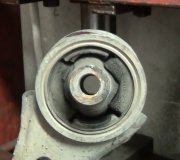We only do four-wheel alignments today, even on vehicles with solid rear axles. By indexing off the rear wheels to know where to set the front wheels, it insures the steering wheel will be straight when we are done.
Any time a steering or suspension part is replaced, you must have the vehicle aligned right away. There are a few exceptions on older vehicles that use a very specific style of ball joint, and that only applies when all the other parts are okay, but for anything else, especially vehicles like yours that have the ball joint built into a control arm assembly, you must finish the repair with an alignment. No two control arms are ever exactly the same. That alone will affect the alignment. GM is famous for building multiple parts into large assemblies so they go together quickly on the assembly line. That saves them money, but you pay for it because you have to buy that entire assembly to get the one part you need. In this case, the alignment adjustment provision is built into the parts. There is no way to know where to adjust the control arm without looking at the numbers on the alignment computer.
I cannot imagine what anyone was doing with a string to set the alignment on a passenger vehicle. We do that on race cars to get the alignment close enough for a starting point. After that, we only use older mechanical alignment gauges because computers cannot handle the wide range of bizarre settings they use.
That equipment gets us within fractions of an inch to settings we know will help the car corner as fast as possible. With that, we hope race car tires will last as much as one hundred miles, but proper wear is not a major concern. With that string between the two front wheels, if we are careful, we can see a mis-adjustment of perhaps eighth inch. That is enough to cause a choppy pattern on passenger car tires. Alignment computers can easily measure to.01 degrees and.01 inches. Even older mechanical alignment gauges cannot get anywhere near that accuracy. We must have that accuracy on every car and truck after the mid 1970's.
To run a string along the side of the van indicates the rear wheel on one side was being adjusted to match the one on the other side. That adjustment is for "toe", the direction the wheel is steering, not for adjusting how far back you want the wheel to sit. While it is a less-effective type of adjustment, you need an alignment computer to know where to set it. That adjustment has nothing to do with where the other wheel is set. That one also was adjusted to set its toe adjustment independent of the other wheel.
All alignment computers are capable of making printouts that list the "before" and "after" readings. The "before" readings are those the vehicle came in with. The "after" readings are those when the alignment was completed. I always high-lighted the "after" numbers for the things I adjusted, then I placed a copy on the passenger front seat. Not all alignment specialists do that because they know very few people know how to interpret those numbers. When you take the van for its alignment, request a copy of the printout, otherwise they probably will not make one. If you post the numbers in your reply, I can interpret them for you. Specifically, I want to see "camber" and "toe" for each of the four wheels. I can explain the tire wear patterns you should have seen based on the "before" readings.
Friday, December 29th, 2017 AT 5:24 PM


